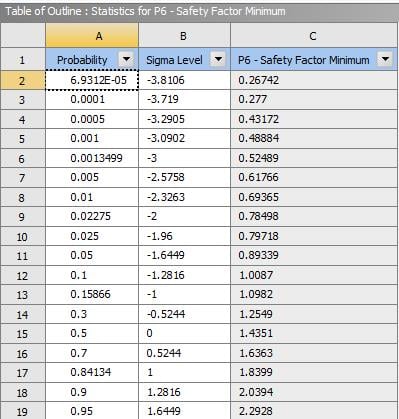-
-
September 8, 2019 at 6:32 pm
Abdoon075
SubscriberHello Experts,,,,
1- How can I parameterize the material properties such as Young's Modulus and Yield strength to use them as a random variables for reliability assessment ???
2- For reliability assessment by using Six Sigma Analysis, how can I define the failure criteria ???
-
September 10, 2019 at 2:36 am
peteroznewman
Subscriber1. Go into Engineering Data and put a check mark in the box next to Young's Modulus. Do the same for Tensile Yield Strength.
I created a beam midsurface model in SpaceClaim and made the width of the beam a Parameter by creating a Group for that in SpaceClaim. Once the beam was brought into Mechanical, I had to assign a thickness to the beam and I made that a Parameter by clicking the P next to the thickness assignment. I added supports and a center load to the beam and made the load a Parameter. Yield Strength only affects Factor of Safety so I added the Minimum Factor of Safety as an output Parameter.
I added a Six Sigma Analysis system to the Workbench Project.
The SSA system created a Design of Experiments and computed a Response Surface.
The SIx Sigma Analysis DOE created a normal distribution about the mean Young's Modulus by using a Standard Deviation.
SSA did the same for the width and thickness of the beam, and the load and yield strength, which were created as the other four input parameters. Then it computed how the Minimum Factor of Safety output varied over those five input parameters with their variation.
The data for the plot above is also in a table. Here are a few rows.
Define failure as maximum equivalent stress > yield strength which is the same as saying Factor of Safety < 1.0
From the table above, you can see that the probability of FOS > 1.0 is 90%, which is the reliability of this design.
-
September 11, 2019 at 10:05 am
-
September 11, 2019 at 3:40 pm
peteroznewman
SubscriberYou define failure for yourself, then you interpret the data to find the cumulative probability of failure, F.
Reliability, R = 1 - F.
For example, in the model above, suppose the specification is the maximum deformation shall be < 25 mm.
That is your definition of failure. If you included maximum deformation as an output in the SSA, there will be a cumulative probability table of deformations and a plot.
Look up the cumulative probability of being less than 25 mm, that is R.
From the table above, you can see R = 99.8% with a Sigma Level of about 3.0 -
August 21, 2023 at 5:29 pm
Tanmay Konnur
SubscriberHi Peter, I am trying to model a process which requires changing the material properties with respect to time. It is a layered deposition and etching process with respect to time. Hence, for simulating etching, I need to change the material properties. What is the best way to do this? Can I do it in the manner you've described in this post?
-
- The topic ‘Parametrizing Material properties’ is closed to new replies.



-
4683
-
1565
-
1386
-
1242
-
1021

© 2025 Copyright ANSYS, Inc. All rights reserved.













